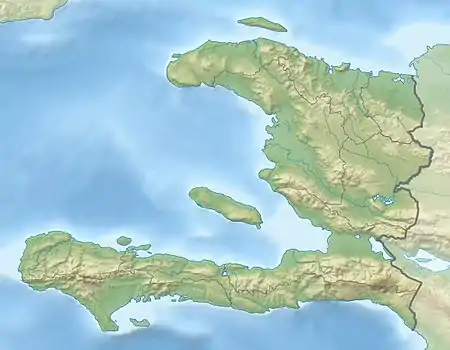Insulacebus
Insulacebus is an extinct monotypic genus of New World monkey found on the island of Hispaniola from Late Quaternary deposits. Fossils of the type species I. toussaintiana have been recovered from the Plain of Formon, Department du Sud, southwestern Haiti. The body mass of the monkey was estimated between 4,159 and 5,443 grams (9.169 and 12.000 lb). The dentally primitive I. toussaintiana was likely derived from a fauna that was evolving on the mainland before the Miocene monkey bed of the Honda Group of central Colombia, and stems from a pre-Middle Miocene colonization from the South American mainland.[1]

| Insulacebus | |
|---|---|
| Scientific classification | |
| Kingdom: | Animalia |
| Phylum: | Chordata |
| Class: | Mammalia |
| Order: | Primates |
| Suborder: | Haplorhini |
| Infraorder: | Simiiformes |
| Parvorder: | Platyrrhini |
| Superfamily: | Ateloidea |
| Tribe: | Aotini |
| Genus: | †Insulacebus Cooke et al. 2011 |
| Species: | †I. toussaintiana |
| Binomial name | |
| †Insulacebus toussaintiana Cooke et al. 2011 | |
See also
- Fossil primates of Central and South America and the Caribbean
- Hispaniola monkey of the Dominican Republic
- Jamaican monkey of Jamaica
- Paralouatta of Cuba
References
- Cooke, S.B.; Rosenberger, A.L.; Turvey, S. (2011). "An extinct monkey from Haiti and the origins of the Greater Antillean primates". PNAS. 108 (7): 2699–2704. Bibcode:2011PNAS..108.2699C. doi:10.1073/pnas.1009161108. PMC 3041101. PMID 21282603.
- Insulacebus at Fossilworks.org
This article is issued from Wikipedia. The text is licensed under Creative Commons - Attribution - Sharealike. Additional terms may apply for the media files.